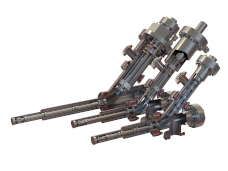EQP Series

For further information and pricing, please get in touch with us.
Systems for Plasma Research
High performance combined mass and energy quadrupole mass spectrometers for the characterisation of plasmas.
EQP-6 300 or 510 amu mass range with 6 mm triple filter quadrupole mass spectrometer for a wide range of plasma research applications.
EQP-9 9 mm triple filter quadrupole-based systems, featuring the broadest range of mass options available. 50 to 5000 amu options for high stability measurements and ion cluster analysis.
EQP-20 featuring Hiden’s 20 mm triple filter quadrupole with zone I/zone H switchable for 20 amu with 0.003 amu peak width, and 200 amu mass range with unit mass resolution for characterisation of hydrogen isotope plasmas.
Applications
Hiden plasma probes measure some of the key plasma parameters and provide detailed information relating to plasma reaction chemistry.
Detailed understanding of the reaction kinetics of plasma ions and neutral species plays a key role in the development of advanced surface engineering processes such as HIPIMS.
The integral electron bombardment ion source provides for analysis of neutrals and, with the addition of the EAMS (electron attachment mass spectrometry) electron attachment mode, for separation and identification of electronegative radical species.
A high transmission 45° sector field energy analyser for positive and negative ion energy analysis up to 1000 eV is included in all of the EQP series instruments.
The EQP Series are available with integrated MCS – multi channel scalar data acquisition with time resolution to 50 nano seconds providing for fast data acquisition in pulsed plasma applications.
Low Pressure Plasma Applications Catalogue
Atmospheric Plasma Applications Catalogue
EQP Series Mass and Energy Analysers
Plasma Etch in Microtechnology
EQP Mass and Energy Analyser for Plasma Diagnostics
Mass Spectrometers for Thin Films, Plasma and Surface Engineering
ALD Atomic Layer Deposition – Vacuum Processing of Thin Films
AP-EQP-202147 – Gas Phase Reaction Dynamics in Pulsed Laser Deposition
AP-EQP-202126 – Characterization of an RF excited broad beam ion source operating with inert gases
AP-EQP-202125 – An Experiment Simulating Titan’s Atmosphere, as Probed by a Hiden Mass Spectrometer
AP-EQP-0011 – TIPS: Test-Bench for Ion Source Plasma Studies
AP-EQP-202014 – Effect of Mo-Cu cathode composition on plasma generation in DC arc synthesis
AP0599 Nanoparticle decoration of carbon nanotubes by sputtering
AP0686 CFx films synthesized by HIPIMS sputtering of carbon
AP-EQP-0005 CH2F+ and CHF2 ion density measurements in argon or krypton-diluted CH2F2 plasmas
AP-EQP-0003 Investigation of Solar Energy Materials
AP0317 Absolute Quantification of Deuterium Ion Fluxes from an ECR Plasma Source
AP-EQP-0004 Negative oxygen ion impingement on SiO2 thin films during growth
AP0280 Advantages of HIPIMS of Silver for Improved E. coli Inactivation
AP0322 Composition and Species Evolution in a Laser-induced LuMnO3 Plasma
AP0371 In-situ Monitoring of the Growth of Silver Thin Film – the Influence of Sputtering Gas
AP-EQP-0001 – Negative-ion Surface Production in Hydrogen Plasmas
Ion energy distributions in dual frequency RF plasmas
EQP Mass and Energy Analyser for Plasma Diagnostics
Mass and Energy Spectra of Plasmas 50 ns Time Resolved Measurements
Time-resolved measurements of mass and energy spectra for plasmas
Energy-Resolved Quadrupole Mass Spectrometry in IIB-VIA Sputtering Investigations
Mass and Energy Spectra of Plasmas 50 ns Time Resolved Measurements
Atmospheric Plasma Analysis by Molecular Beam MS
Atmospheric Pressure Plasma Analysis ICPIG
Effects of Pulsing on the P-CFUBMS of CrAIN Coatings
Ion Energy Distributions for a DC Plasma
Surface Analysis by Plasma Assisted Desorption Ionisation Mass Spectrometry (PADI-MS)
Ames Technology Capabilities and Facilities | Plasma Diagnostics
PSI – Paul Scherrer Institut | Plasma & Thin Film Analysis

The system is supplied with MASsoft Professional software.
This Windows 10 and Windows 11 compatible software allows control of the instrument via USB 2.0, RS232 or Ethernet. Provides comprehensive I/O for data output and for reading data from external devices for integration and display with mass spectrometer data.

